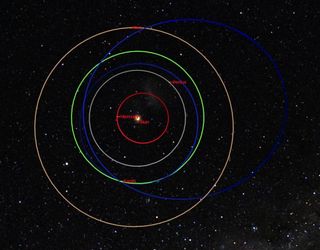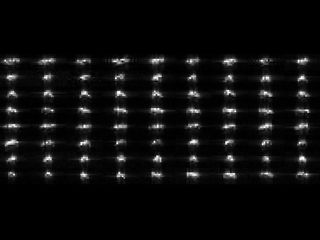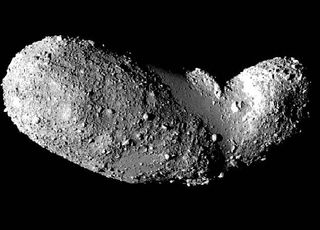NASA Unveils 1st Radar Video of Asteroid Flyby

NASA has revealed the first radar video of an asteroid flyby that sent a space rock half the size of a football field buzzing by Earth last week.
The new asteroid flyby video, released today (Feb. 19), shows the asteroid 2012 DA14 as it headed away from Earth over the weekend. The asteroid zipped close by Earth on Friday (Feb. 15), when it approached closer to the planet than many communications satellites.
Before Friday's flyby, astronomers suspected asteroid 2012 DA14 was about 150 feet (45 meters) across. At its closest point, the asteroid came within 17,200 miles (27,000 kilometers) of Earth, but never posed a threat of impacting the planet.
Based on the new radar observations, scientists now think asteroid 2012 DA14 is about 130 feet (40 m) wide at its largest point, NASA officials said in a statement.

The new video of the asteroid was made by combining radar observations of 2012 DA14 by NASA's Deep Space Network radio antenna in Goldstone, Calif. The 230-foot (70 meters) antenna captured 72 images of asteroid 2012 DA14, which was about 74,000 miles (120,000 kilometers) from Earth at the time, during observing windows on Friday and Saturday (Feb. 15 and 16). The images have a resolution of about 13 feet (4 m) per pixel. [See more photos of asteroid 2012 DA14]
"The images span close to eight hours and clearly show an elongated object undergoing roughly one full rotation," NASA officials explained. During that eight hours, asteroid 2012 DA14 moved even farther from Earth to a point about 195,000 miles (314,000 km) away.
Astronomers Lance Benner and Marina Brozovic at NASA's Jet Propulsion Laboratory in Pasadena, Calif., led the radar observing campaign for the asteroid flyby. They planned to conduct a series of follow-up observations on Feb. 18, 19 and 20.
Get the Space.com Newsletter
Breaking space news, the latest updates on rocket launches, skywatching events and more!
Asteroid 2012 DA14 was discovered in February 2012 by amateur astronomers at the La Sagra Observatory in Spain. Its close flyby was determined soon afterward, and astronomers ultimately found that it posed no chance of hitting the Earth.
NASA scientists and astronomers around the world tracked asteroid 2012 DA14 as it approached Earth over the last week, with the space agency and several groups holding public webcasts to chronicle the space rock's close shave. It was the closest flyby of an asteroid the size of 2012 DA14 that astronomers have known about in advance.
Asteroid 2012 DA14 came about 5,000 miles (8,046 km) closer to Earth than the fleet of communications satellites that fly in geosynchronous orbits about 22,400 miles (36,000 km) above the planet. NASA provided satellite operators with regular updates on the asteroid's position and path in case the satellites would have to be moved clear of the space rock.
NASA and a network of scientists around the world regularly monitor the night sky for signs of asteroids that could pose an impact threat to the Earth.

NASA scientists have said the trajectory of the meteor was different than that of asteroid 2012 DA14, and that the two events were unrelated. Subsequent fireball sightings over the San Francisco Bay Area and Miami, Fla., were also unrelated.
You can follow SPACE.com Managing Editor Tariq Malik on Twitter @tariqjmalik. Follow SPACE.com on Twitter @Spacedotcom. We're also on Facebook & Google+.
Join our Space Forums to keep talking space on the latest missions, night sky and more! And if you have a news tip, correction or comment, let us know at: community@space.com.

Tariq is the Editor-in-Chief of Space.com and joined the team in 2001, first as an intern and staff writer, and later as an editor. He covers human spaceflight, exploration and space science, as well as skywatching and entertainment. He became Space.com's Managing Editor in 2009 and Editor-in-Chief in 2019. Before joining Space.com, Tariq was a staff reporter for The Los Angeles Times covering education and city beats in La Habra, Fullerton and Huntington Beach. In October 2022, Tariq received the Harry Kolcum Award for excellence in space reporting from the National Space Club Florida Committee. He is also an Eagle Scout (yes, he has the Space Exploration merit badge) and went to Space Camp four times as a kid and a fifth time as an adult. He has journalism degrees from the University of Southern California and New York University. You can find Tariq at Space.com and as the co-host to the This Week In Space podcast with space historian Rod Pyle on the TWiT network. To see his latest project, you can follow Tariq on Twitter @tariqjmalik.
